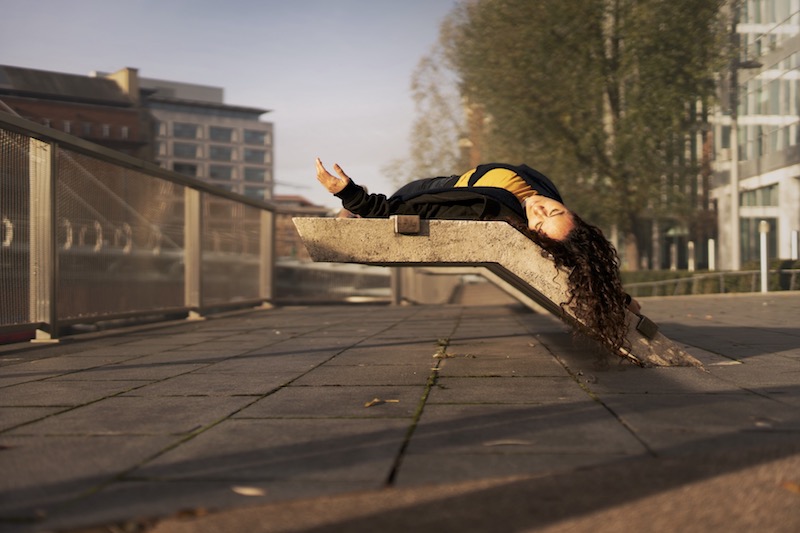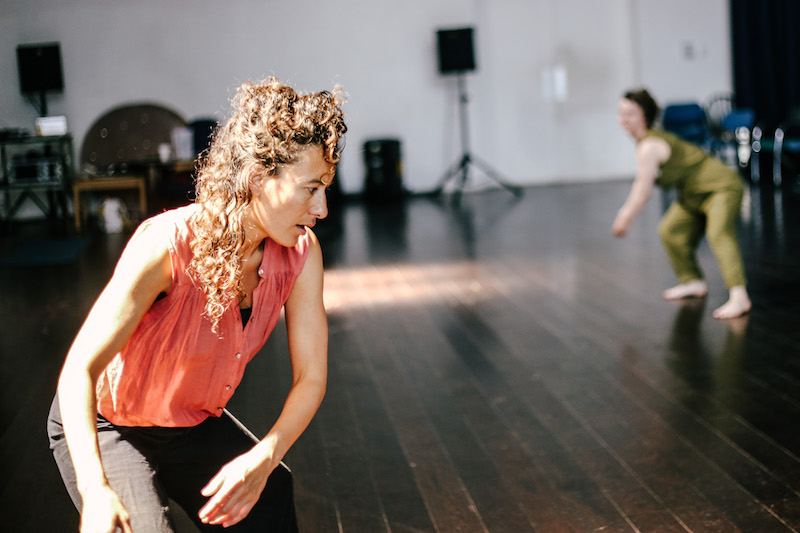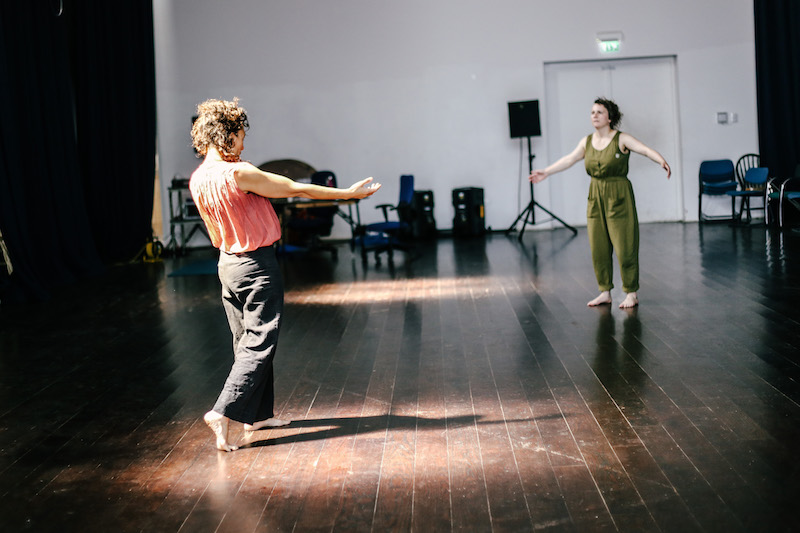by Aoife Donnellan // Oct. 11, 2024
This article is part of our feature topic Accessibility.
Access in exhibition-making is often reduced to accommodations considered after the creation and installation of work rather than as an integral part of the artistic process. In her introduction to ‘Curating Access: Disability Art Activism and Creative Accommodation’ (2023), curator Amanda Cachia categorises creative access as a “theoretical and practical generative force” that can transform the gallery and museum site for every visitor. Echoing Cachia’s examination of “access as praxis,” UK-based dance theatre practitioner Raquel Meseguer Zafe uses rest and horizontality as artistic methods to create performance work and encounters that explore the experiences of people with invisible disabilities. Her interdisciplinary approach uses installation, sound, movement and storytelling to illustrate the lived experiences of disability through the creation of collective experiences. Prompted by Meseguer Zafe’s personal experience of lying down in the Southbank Centre and triggering the alarm, her work ‘A Crash Course in Cloudspotting’ (2022) collected stories from over 300 “cloudspotters” about their experiences of resting in public. She is currently the Co-Artistic Director of Candoco, a contemporary dance company that fosters collaboration between mainstream and experimental practices that address dance and disability. Her work interrogates the functionality of shared spaces, and encourages alternative engagement in public space. We spoke about horizontality, collective knowledge and the role of collaboration in creating accessible work.

Raquel Meseguer Zafe: ‘A Crash Course in Cloudspotting’ // Photo by Paul Samuel White
Aoife Donnellan: Your practice often involves research, for example your ‘Crip Tech & Belonging’ (2021) publication where you spoke with six artists with disabilities about how their experience influences the art they produce. How does your research practice influence your work?
Raquel Meseguer Zafe: I realised that I’ve been using research, or gathering other people’s stories, to make work since 2011 when I volunteered on the Thai-Burma border for a year. I started off teaching English, and then I was invited to run some theatre and movement workshops in some of the refugee camps and other places where migrant children were staying long term. I realised that it’s really from them, and from engaging with Augusto Boal’s work, that I’ve been interested in talking to the groups of people that I’m working with.
With ‘Crip Tech & Belonging,’ I reached out to six artists to do long-form interviews, and then tried to gather all the hacks that we had collectively. I’m really interested in people’s everyday wisdom and what they’ve learned about how they can bypass systems, how they can hack things to make their worlds a bit bigger, or to make their worlds exist at all within a very normative system: to crip it from within. That’s why I like to reach out to people, it’s a belief in collective knowledge. In ‘Cloudspotting’, we collected over 300 stories about people’s attempts to rest in public, and then some of them are featured in the installation performance piece that is ‘A Crash Course in Cloudspotting,’ and about 60 of them exist on our cloudspotting archive, which is a home for all those stories.

Raquel Meseguer Zafe, Trinity Centre, Bristol // Photo by Chelsey Cliff
AD: Do you think that multidisciplinary practices and collaboration are central to creating work that is accessible?
RMZ: The answer is probably yes. When you start to think about accessibility or about non-normative stories from the beginning of a work, you often end up evolving a new format, and you need to collaborate with experts to do it. There’s no point in making a piece for chronically ill folks without working with chronically ill folks.
Sins Invalid in America have a beautiful disability manifesto, ‘10 Principles of Disability Justice.’ One of the principles is “leadership of those most impacted,” which I really believe in when making work for disabled audiences, or making work that is going to include disabled performers and disabled stories.
In my new project ‘Proper Time’—which is going to be a trio for three chronically ill performers—we’re thinking about how we can meet the audience however our conditions are presenting, which might mean that we’re physically or digitally there, or maybe not at all. In terms of access, we’re trying to think about creative tech to give audiences meaningful ways to interact with the space if they can’t be there, giving them agency to turn lights or sounds on and off, or to trigger a blackout, or to phone in to read some text and deliver a dialogue with an another audience member.
AD: Your work is often architectural, shaping environments and prioritising the ways in which space can support the body. Through what processes do you consider the body in your practice and what role does technology play?
RMZ: I spend a lot of time thinking about how I can be more supported by the space around me. Often, my pain levels feel uncontainable, they feel so big that they don’t even really obey the skin line sometimes. I have all these tricks to keep expanding and often that does mean coming into a different relationship to the space around me. I think a lot about the body as a landscape.
When we did ‘Cloudspotting’ and invited the audience to rest, we stumbled upon something, which is that when you are at rest, you’re more open, receptive and dreamy. We found that the stories landed differently in the body and the audience had this sense of authorship, because it was a predominantly audio work, and they were authoring it themselves. In relation to tech, it made me think of what possibilities it gives to speak to one another’s bodies beyond the skin line. I try to fight against this idea that in-person is better than via technology, because technology makes my life so much more accessible. I think technology can aid those connections in different ways, in ways that being together in person can’t.

Raquel Meseguer Zafe, Trinity Centre, Bristol // Photo by Chelsey Cliff
AD: In terms of the body as a landscape, you often use horizontality as a way to bring about a different way of communication between participants and the work. Could you expand on the role horizontality plays in your practice?
RMZ: Considering my body as a landscape is thinking about it as an embodied space of wisdom and knowledge, which overlaps with a lot of decolonizing practices at the moment that are honouring and lifting pre-colonial, pre-industrial knowledge. Maybe that is some of what horizontality does.
I also use it to create horizontal events that give people a different way of engaging with art. I worked with Arnolfini [arts centre] to create these long, meditative guided rests that give the audience a chance to engage with a painting in a different way. We did one that was called ‘Rest Improvised,’ and it was part of a weekend that was curated by Gaylene Gould. I worked with Jamie McCarthy, who’s a musician-composer that I work with often, and we guided people through a 50-minute rest. There were these huge, beautiful artworks by Frank Bowling, really massive pieces of colour, light, movement and texture. We had beanbags and yoga mats all over the gallery, and then people chose where they wanted to be. Often they had this quite psychedelic, in-depth experience with the artworks, because we created this structure for them to rest and be with one thing for 50 minutes. We were disrupting the predictable pace that people move around a gallery.


Raquel Meseguer Zafe: ‘A Crash Course in Cloudspotting,’ 2021 at Herbert Art Gallery Coventry // Courtesy of the artist
AD: I’m really interested in the way that your work brings these moments about in a shared way, rather than in an individual way, because rest is often atomized and restricted to private spaces, whereas your practice encourages a “misbehaviour” or disruption of expectations surrounding the body in public spaces.
RMZ: I feel like something I discovered with this rest practice is how weird people are about private needs showing up in public spaces. On that thing of misbehaving: it was accidental, but I started resting in public because my world had gotten really small. I triggered the security alert at the Southbank Centre by lying down there, and ‘Cloudspotting’ grew from there. I feel like misbehaving is central to crip practice. Michael Turinsky in ‘Precarious Moves’ describes crip as resistance. For me, crip really is a noun that some of us use. We’re reclaiming that word. It’s also a verb, to crip something, to playfully and naughtily change it so that it suits you more. That misbehaving, naughty aspect of crip is something I really enjoy, and something that the language of disability and impairment doesn’t invite, whereas crip really does.


























